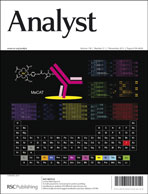Dual signal amplification strategy for the fabrication of an ultrasensitive electrochemiluminescenct aptasensor†
Abstract
A dual signal amplification strategy was designed to construct a cathodic peroxydisulfate-based electrochemiluminescence (ECL) aptasensor for the ultrasensitive detection of thrombin (TB) as a model analyte. The signal was amplified by the employment of two kinds of co-reactant, (1) in situ generated dissolved O2 from the cascade catalysis of GOD and HRP as co-reactants and (2) intercalation of a new co-reactant into the grooves of the dsDNA polymers based on the hybridization chain reaction (HCR). Femtomolar levels of TB could be detected using the developed aptasensor, with high sensitivity and good stability. Thus the S2O82−–O2 ECL system has great potential for development and application in clinical diagnostics, immunology and biomedical research.


 Please wait while we load your content...
Please wait while we load your content...